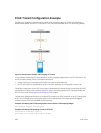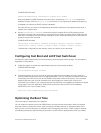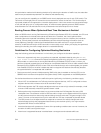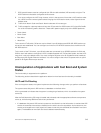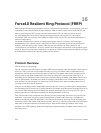• The system ensures that local routes known to BGP are imported into BGP and advertised to peers as
quickly as possible. In this process, any advertisement-interval configuration is not considered (only
during the initial period when the peer comes up).
If you do not configure BGP GR, you must configure the peering with BGP keepalive and hold timers to
be as high as possible (depending on your network deployment and the scaled parameters or sessions) to
enable the connection to be active until the system re-initializes the switch, causing the links to adjacent
devices to go down. If the BGP sessions are disabled before the re-initialization of the switch occurs
because of the peer timing out, traffic disruption occurs from that point onwards, even if the system
continues to maintain valid routing information in the hardware and is capable of forwarding traffic.
LACP and IPv6 Routing
The following IPv6-related actions are performed during the reload phase:
• The system saves all the dynamic ND cache entries to a database on the flash card. After the system
comes back online, and the Dell Networking OS image is loaded and the corresponding software
applications on the system are also activated, the following processes specific to IPv6 are performed:
• If a database of dynamic ND entries is present on the flash, the information is read and the ND entries
are restored (to the IPv6 subsystem as well as the kernel); the entries are installed on the switch as
quickly as possible. At the same time, the entries are changed to an initial (“incomplete”) state so that
they are refreshed (and flushed, if not learnt again). The database on the flash is also deleted
immediately.
• To ensure that the adjacent systems do not time out and purge their ND cache entries, the age-out
time or the reachable time for ND cache entries must be configured to be as high as necessary. Dell
recommends that you configure the reachable timer to be 90 seconds or longer.
BGP Graceful Restart
When the system contains one or more BGP peerings configured for BGP graceful restart, fast boot
performs the following actions:
• A closure of the TCP sessions is performed on all sockets corresponding to BGP sessions on which
Graceful Restart has been negotiated. This behavior is to force the peer to perform the helper role so
that any routes advertised by the restarting system are retained and the peering session will not go
down due to BGP Hold timeout.
• Termination of TCP connections is not initiated on BGP sessions without GR because such a closure
might cause the peer to immediately purge routes learnt from the restarting system.
• When BGP is started, it sets the R-bit and F-bit in the GR capability when bringing up the session with
peers for which BGP GR has been configured. This is the standard behavior of a restarting system and
ensures that the peer continues to retain the routes previously advertised by the system.
• The system delays sending the BGP End-of-RIB notification to peers with whom BGP GR has been
negotiated to ensure that the local routes of the system are advertised to the peers, if required by the
configuration.
• If BGP GR is enabled on any peering session, the timeout values used for the BGP hold timer do not
take effect.
Cold Boot Caused by Power Cycling the System
When you perform a power-cycle operation on a system that is configured with the optimized booting
functionality, the system goes through its regular boot sequence even if it is configured for fast boot.
346
Flex Hash and Optimized Boot-Up





